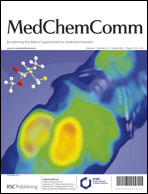Bioguided discovery and pharmacophore modeling of the mycotoxic indole diterpene alkaloids penitrems as breast cancer proliferation, migration, and invasion inhibitors†
Abstract
Marine-derived fungi have proven to be important sources of bioactive natural organohalides. The genus Penicillium is recognized as a rich source of chemically diverse bioactive secondary metabolites. This study reports the fermentation, isolation and identification of a marine-derived Penicillium species. Bioassay-guided fractionation afforded the indole diterpene alkaloids penitrems A, B, D, E and F as well as paspaline and emnidole SB (1–7). Supplementing the fermentation broth of the growing fungus with KBr afforded the new 6-bromopenitrem B (8) and the known 6-bromopenitrem E (9). These compounds showed good antiproliferative, antimigratory and anti-invasive properties against human breast cancer cells. Penitrem B also showed a good activity profile in the NCI-60 DTP human tumor cell line screen. The nematode Caenorhabditis elegans was used to assess the BK channel inhibitory activity and toxicity of select compounds. A pharmacophore model was generated to explain the structural relationships of 1–9 with respect to their antiproliferative activity against the breast cancer MCF-7 cells. The structurally less complex biosynthetic precursors, paspaline (6) and emindole SB (7), were identified as potential hits suitable for future studies.


 Please wait while we load your content...
Please wait while we load your content...